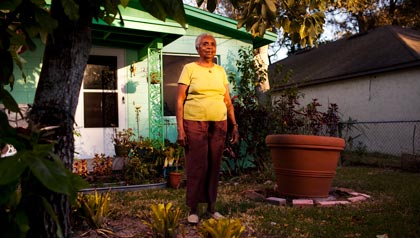AARP Hearing Center

By Linda H. Lamb •
Joyce Swain has lived in her cozy Florida home for more than 40 years—and she would like to stay there many years more.
That’s why Swain, who has arthritis, is pleased with modifications she made on the advice of Carolyn Sithong, an occupational therapist and lead Home Fit volunteer for AARP Florida. Among the improvements, Swain’s bathroom now has two sturdy bars that let her get in and out of the bathtub more easily and safely.
“Every time I use them, I say, ‘Thank God for these bars,’ ” said Swain, 74, a retired city clerk who lives in Eatonville, near Winter Park.
Home Fit seminars planned
AARP Florida’s Home Fit program offers practical information to older adults whose homes could use some upgrades.
“We have overwhelmingly heard from our members that they prefer to remain in their homes—to ‘age in place.’ But there are safety concerns,” said Laura Cantwell, senior program specialist with AARP Florida.
AARP Florida is planning Home Fit events this year in Tampa Bay, Orlando, Tallahassee and Jacksonville. (Materials in Spanish are being developed.)
At the meetings, people can learn about options for making homes safer, pick up free materials—including a 21-page Home Fit Guide—and sometimes examine vendor displays of safety equipment.
Many older Floridians are downsizing and making lifestyle changes anyway, so it’s a good time to think about homes with safety features. But “it still can be a challenge to get people to think ahead,” Cantwell said. “Education is a big part of it.”
Statistics back up the need for greater awareness about home safety. According to the federal Administration on Aging, almost 30 percent of noninstitutionalized older adults live alone, including almost half of women 75 and older.
And while it’s nice to have quick assistance if you’ve fallen, it’s better to prevent a fall in the first place. Falls are the leading cause of injury deaths among older adults, according to the federal Centers for Disease Control and Prevention. About half of all falls happen at home.
For older people, “all those feelings associated with home are still there, feelings of comfort and safety,” Sithong said. “But the environment might not let them do all the things they need to do.”
Bathroom safety is a big concern, and extensive renovations can cost tens of thousands of dollars. But sometimes there’s a less expensive approach, she said, such as “not buying the walk-in tub but working with what you have.”
For example, a handyman can install grab bars like those that make Swain’s life easier. Some newer safety bars do double duty as towel or toilet paper holders, and some even coordinate with the decor. Modifying a too-low toilet can be as simple as purchasing a raised toilet seat for $50 or less or using a safety frame that helps people sit down and stand back up.
For major renovations, AARP advises consulting a contractor certified by the National Association of Home Builders as an aging-in-place specialist. He or she will evaluate your home and advise on modifications to meet your needs.
More safety tips
Home Fit experts also recommend:
- Lever handles to make doors and faucets easier to use.
- Additional lighting, especially to dimly lit stairs and work areas, and rocker light switches that work easily.
- Nonslip decals, tub seating and a handheld shower attachment to make bathing safer.
- Large drawer knobs that are easier to grasp for people who have arthritis. Roll-out shelves and drawers improve access.
For more pointers about aging in place and information on the next Home Fit meeting, visit the AARP Florida website.
Linda H. Lamb is a freelance writer living in Columbia, S.C.































































